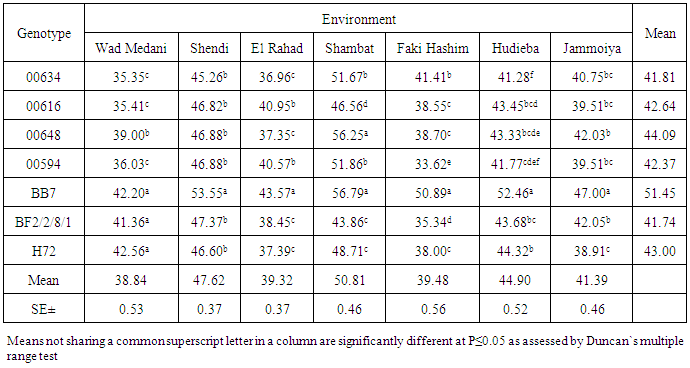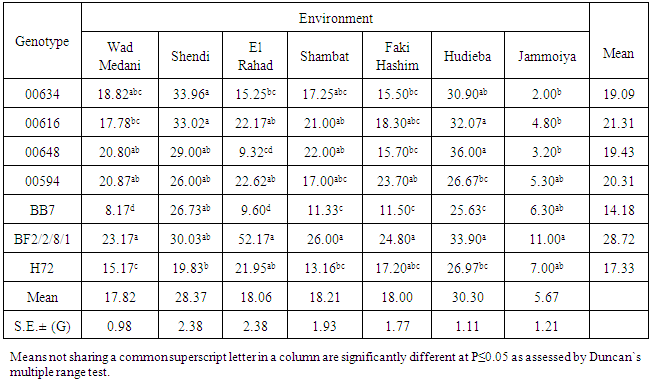-
Paper Information
- Previous Paper
- Paper Submission
-
Journal Information
- About This Journal
- Editorial Board
- Current Issue
- Archive
- Author Guidelines
- Contact Us
International Journal of Agriculture and Forestry
p-ISSN: 2165-882X e-ISSN: 2165-8846
2015; 5(5): 276-280
doi:10.5923/j.ijaf.20150505.02
Impact of Different Agro Ecological Environments and Genotypes on Some Quality Aspects of Faba Bean (Vicia Faba L)
Mohamed E. O. Elsayed1, Ahmed M. El-Naim2
1Department of Biochemistry and Food Technology, Faculty of Natural Resources and Environmental Studies, University of Kordofan, Elobeid, Sudan
2Department of Crop Sciences, Faculty of Natural Resources and Environmental Studies, University of Kordofan, Elobeid, Sudan
Correspondence to: Ahmed M. El-Naim, Department of Crop Sciences, Faculty of Natural Resources and Environmental Studies, University of Kordofan, Elobeid, Sudan.
| Email: |  |
Copyright © 2015 Scientific & Academic Publishing. All Rights Reserved.
An experiment was conducted in Sudan to investigate the effect of genotypes on some seed quality aspects of faba bean grown in different agro ecological environments. The results showed that the quality aspects of seeds: 100-seed weight, non-soaker percentage, hydration coefficient and cook-ability percentage were influenced significantly by the Environment and genotype. The Highest seed weight was obtained from Shambat environment, highest cook-ability percentage in Hudieba, while the higher hydration obtained from Jammoiya environment. The genotype BB7 had a heavier 100-seed weight. However, BF2/2/8/1 genotype had the highest hydration coefficient and cook-ability percentage at all environments.
Keywords: Broad bean, Hydration coefficient, Non-Soaker, Cook-Ability
Cite this paper: Mohamed E. O. Elsayed, Ahmed M. El-Naim, Impact of Different Agro Ecological Environments and Genotypes on Some Quality Aspects of Faba Bean (Vicia Faba L), International Journal of Agriculture and Forestry, Vol. 5 No. 5, 2015, pp. 276-280. doi: 10.5923/j.ijaf.20150505.02.
Article Outline
1. Introduction
- Faba bean (Vicia faba L.) is one of the most important legume crops used as food for human consumption in developing countries and as animal feed in advanced countries [1]. It is the fourth important pulse crop in the world after dry bean, dry peas, and chickpeas [2]. Its centre of origin is a Mediterranean or West Asia [3] and was first cultivated in North Africa [4]. In several African countries, particularly in Sudan faba bean is the most important legume seed consumed directly as human food for instance stewed faba beans (fool madamas), bean cakes (flafel or taamia) or germinated bean (fool nabet) [5]. The widespread consumption of faba beans may be because they are easy to prepare at home and store as well as their acceptable taste and flavor. Moreover, most of the families prefer faba beans dishes for breakfast and supper. Additionally, the crop is an imperative source of income for the farmers in the country [6]. In Sudan, faba bean is one of the primary grown and consumed legume crops. It constitutes to the primary human nutrition, supplying high-quality proteins essential for a balanced diet for the daily breakfast and dinner of the millions of people who can not afford meat as a source of protein in both rural and urban areas [7]. The area occupied by faba bean about 60% of the pulse acreage followed by haricot bean, chick pea and lentil [8]. Faba baen is an important source of plant protein [9]. Its value as a food and feed crop lies in its high lysine-rich protein, vitamins, minerals, and carbohydrates [10], which make it one of the best solutions to the malnutrition, particularly in developing countries in Africa and parts of Asia and Latin America [11]. The popularity of faba bean may be due availability of relatively reasonable prices compared to other food commodities, higher meat prices and milk production is inadequate especially for preschool and school children, malnutrition is a common feature in this vulnerable group. Faba beans, like other beans, are a good source of calories, protein, carbohydrate and fibre [12]. The quality of faba bean seeds is of great importance not only to consumers or processor but also to the plant breeder and farmer. There are many factors affecting seed quality in faba bean. These factors include a variety or genotype, cultural practices and/or environmental conditions. Ali et al. [13] argued that the locality could be considered as an important factor affecting the different characteristics of faba bean in particular the physical characteristics, e.g. total defects, hydration coefficient that are very important factors affecting cooking quality of faba beans. Faba beans are traditionally grown in the fertile (Gureir) soils, those are silty loams deposited in a narrow strip along the banks of the Nile and on isolated islands. Due to the scarcity of fertile soil and the high demand for aba bean coupled with the ever increasing prices, new land are coming up into production [22]. The quality of faba bean produced in new areas has always been characterized by having a high percentage of non-soaker, low percentage of hydration and poor cook-ability, consequently poor quality attributes are rendering the production of this crop in the mentioned areas unfeasible [23]. Very meager research work has been reported regarding the quality aspect of faba bean and the possible causes of hard seed in faba bean from physical, biochemical and genetic stands points of possible solutions. The objective of the present research was to study the effects of different agro-ecological environments and genotypes on some quality aspects of seeds of faba bean.
2. Materials and Methods
2.1. Materials
- Seeds of seven faba bean genotypes, grown at different agro-ecological environment in Sudan viz: Wad Medani, Shendi, El Rahad, Faki Hashim, Hudieba and Jammoiya. The genotypes used were 00634, 00616, 00648, 00594, BB7, BF2/2/8/1 and H72. The treatments arranged in randomized complete block design with three replicates. The seed supplied by the Agricultural Research Corporation (ARC) Shamabat, Sudan.
2.2. Tests for Some Quality Aspects
- Tests of some quality aspects: 100-seed weight, non-soaker percentage, hydration coefficient and cook-ability were determined according to the methods described by Hulse et al. [24] and Ali et al. [18]. From each samples, 100 seeds were counted randomly in triplicate and weight was recorded. All samples were soaked overnight (16 hours) at room temperature. The percentage of the non-soaker for each sample was calculated after sorting and weighing of non-soaker seeds. The hydration coefficient was calculated as follows:
 Twenty grams of soaked seeds were processed at 230 °F for 30 minutes, then the sample was reweighed after processing. The cook-ability was calculated as follows:
Twenty grams of soaked seeds were processed at 230 °F for 30 minutes, then the sample was reweighed after processing. The cook-ability was calculated as follows:
2.3. Statistical Analysis
- Each sample was analyzed in triplicate and the figures were averaged. The data was subjected to the analysis of variance (ANOVA) [14]. The Means separation by using the Duncan`s multiple range test.
3. Results and Discussion
- Analysis of variance revealed that there were significant (P≤0.01) differences among the seven genotypes and the seven environments in these parameters. Also, there interaction between the genotype and the environment was also significant (P≤0.01) for all investigated parameters, which indicates that both genotype and agro ecological environment affected mentioned parameters. The relative ranking of the seven genotypes varied among the environments. The genotype BB7 was leading for 100-seed weight at all environment except at Wad Medani. The genotype H72 had the highest value (Table 1). On the other hand the genotype BF2/2/8/1 was leading for non-soaker percentage at four environments (Table 2). Among the major factors that affect non-soaker percentage are environmental conditions, locality, harvesting time and agronomic practices [15].The incidence of hard seed not only reduces the germination percentage, but also adversely affects the cooking quality and therefore the market price of the product [25]. Hardness of the seed is the type of seed dormancy i.e. impermeability of seed coat to water and gases and physical resistance to embryo expansion. Hard faba bean fail to germinate readily when all necessary conditions are provided. However, the impermeable seed character can be beneficial in maintaining seed viability of normal permeable one [26]. With regard to hydration coefficient and cook-ability percentage, BF2/2/8/1 was the best cultivar at all locations (Table 3) and (Table 4).High hydration coefficient indicates that these seeds are capable of imbibing water efficiently after soaking and it is a valuable quality factor for consumers [15]. The hydration coefficient is a very valuable attribute for both consumer and processor. It is a good indicator of quality because it plays a major role in defining the ability of the seeds to absorb water and hence become ready for cooking processes. However, it can be affected by the percentage of total defects which are mainly due to the presence of non-soakers. Shehata et al. [16] revealed that the variation in cooking time of legume seed has been known for a long time and has been attributed to genetic and environmental factors particular to climate condition and available nutrients (P, K) in soil. The correlation between the quality aspects showed that the hydration coefficient was significant and positively (r = +0.41) correlated with cook-ability percentage, but it was significantly and negatively (r = -0.79) correlated with non-soaker percentage. Non-soaker percentage was also significantly and negatively (r = -0.33) correlated with cook-ability percentage. Generally the results in accordance with those of Salih et al. [17] for 100-seed weight, Ali et al. [18] for non-soaker percentage and cook-ability percentage and Ali et al. [13] for hydration coefficient. The ranges obtained from all parameters were greater than that obtained by Siddig [19]. Hundredn seed weight and hydration coefficient results of faba beans acquired by Elhabib [20] and Elsayed et al. [21] were lower than these findings. The data of non-soaker percentage was in the range of the results of Elsayed et al. [21]. Moreover, non-soaker percentage and hydration coefficient were higher than the results of Elsheikh and Ahmed [15].
|
|
|
|
4. Conclusions
- The results revealed that genotype BF2/2/8/1 considered as a future prospect cultivar for its good quality attributes. Faki Hashim, Hudieba and Shendi were recommended as a favorable environments for the production of highest quality faba bean. Generally, the quality aspects of faba bean were influenced significantly by the genotype and environment. Therefore, a further profound field investigation were recommended.
 Abstract
Abstract Reference
Reference Full-Text PDF
Full-Text PDF Full-text HTML
Full-text HTML


